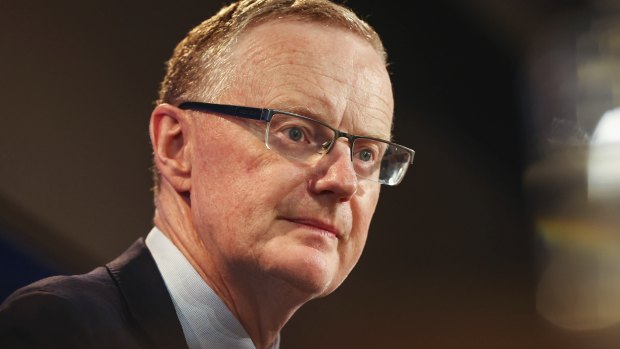This was published 3 years ago
Homeowners on notice higher rates on cards as economy mends
By Shane Wright and Jennifer Duke
Homebuyers who have used low interest rates to drive house prices to all-time highs and take on record levels of debt are being warned they face a steep increase in repayments, with the Reserve Bank signalling it wants the official cash rate to eventually climb to 2.5 per cent.
While trying to play down the immediate threat of a rate rise, RBA governor Philip Lowe on Tuesday made clear the bank measured success by getting the cash rate – currently at a record low 0.1 per cent – back to 2.5 per cent if not a little higher.

RBA governor Philip Lowe says success for the bank would be seeing interest rates at 2.5 per cent or higher.Credit: Dominic Lorrimer
While financial markets are pricing in an official rate rise by the middle of next year, Dr Lowe said he still believed 2024 was the most likely jumping-off point.
This week, Prime Minister Scott Morrison said the government was committed to “keeping downward pressure” on interest rates, in an echo of the campaign run by then party leader John Howard in the 2004 election.
But Dr Lowe said higher interest rates would mean the economy was mending, inflation was back within the RBA’s 2-3 per cent target band and wages were growing reasonably strongly.
“We’re trying to get interest rates up over time. If we’re successful, interest rates will go up. People borrowing today need to remember that,” he said.
Dr Lowe said he would hope to get official interest rates back to a “neutral rate” of at least 2.5 per cent, if not 3.5 per cent.
An increase to 2.5 per cent would lift the repayments on a $750,000 mortgage, the current average loan for an established house in NSW, by $1004 a month or $12,048 a year. At 3.5 per cent, home loan repayments would climb by $1468 a month or $17,616 a year.
On the average $634,000 Victorian mortgage, a 2.5 per cent cash rate would increase repayments by $849 a month or $10,188 a year. At 3.5 per cent, monthly repayments would be $1241 higher while over a year they would be almost $15,000 more expensive.
One of the reasons financial markets are tipping the bank to lift interest rates next year is due to a lift in wages growth.
But Dr Lowe said that would mean turning around a 10-year step-down in wages, describing the chance of that occurring in the next few months as “close to zero”. Figures to be released on Wednesday by the Australian Bureau of Statistics are expected to show wages growth lifting from its current level of 1.7 per cent.
However, he conceded interest rates could start climbing before 2024, especially if global inflationary pressures became embedded in international supply chains.
Finance Minister Simon Birmingham said Dr Lowe’s speech was a well-considered take on global inflationary pressures, which he described as transitory.
He said the government was focused on keeping jobs growth high and taking unemployment down towards 4 per cent in an environment where “interest rates remain broadly low”.
“We’ve created one of the most exceptional economic results in the world,” he said.
But shadow treasurer Jim Chalmers said the government was running away from the fiscal and economic mess it had created
“This is a prime minister with a budget with a trillion dollars in debt and not enough to show for it because it’s absolutely riddled with rorts and riddled with waste and mismanagement,” he said. “He’s got a record of weak economic growth, stagnant wages, weak business investment, weak productivity, right across the board.”
Commonwealth Bank head of Australian economics Gareth Aird said it appeared the RBA was convinced the path back to higher inflation – and higher interest rates – was a long one.
Mr Aird, who expects the RBA to start lifting interest rates in November 2022, said upcoming wages and inflation data could trip up the bank’s plans.
“It will be up to the official quarterly prints on Australian inflation and wages to make the case that the RBA’s profile is too conservative given the RBA has not used the offshore experience of higher inflation and wages outcomes as a template for what may happen locally,” he said.
Fascinating answers to perplexing questions delivered to your inbox every week. Sign up to get our new Explainer newsletter here.